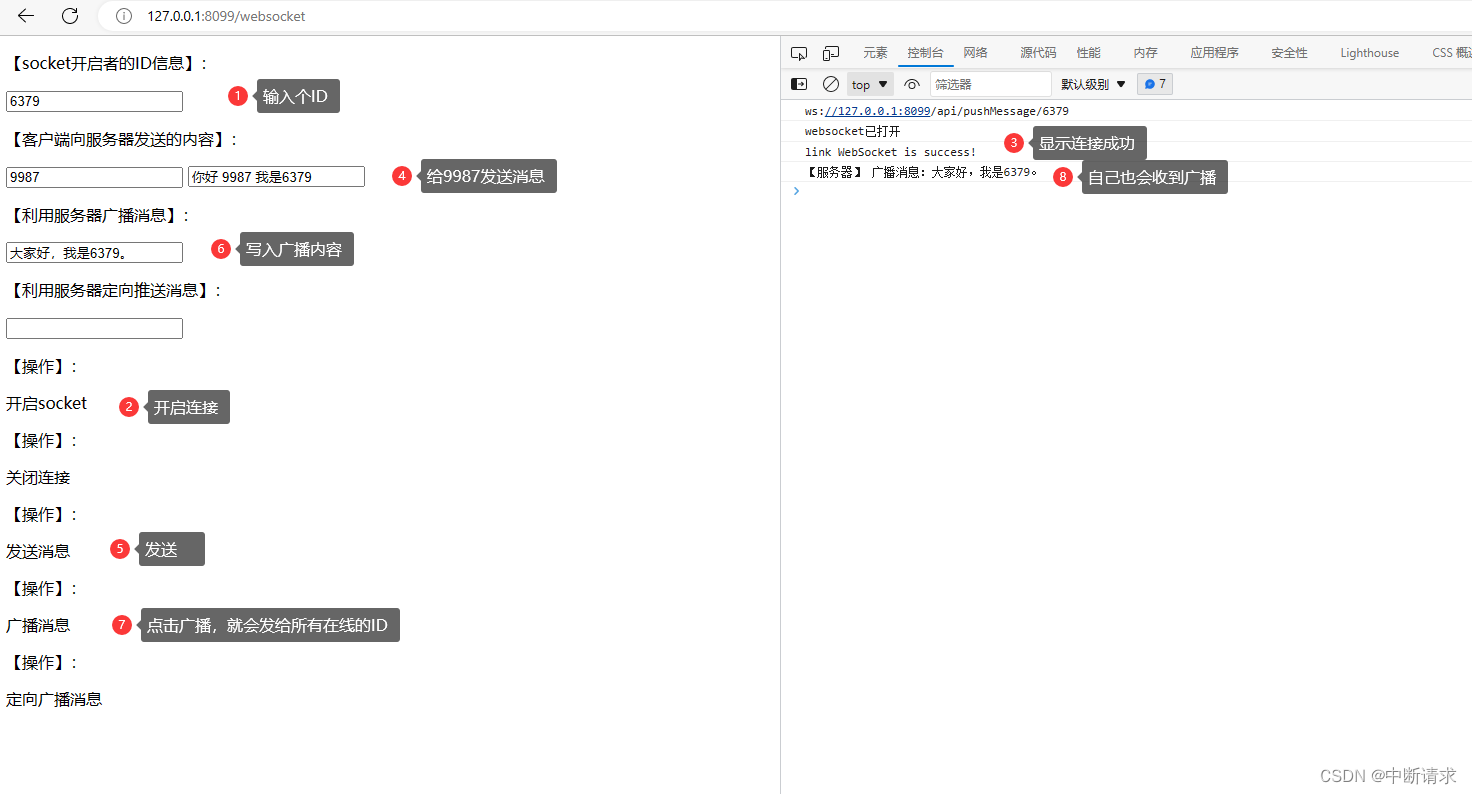一、概述
Websocket是一种基于TCP的全双工通信协议,像我们日常使用的http协议是一种“半双工”也就是只能是客户端请求----服务器响应。而Websocket却可以实现让服务器主动给客户端发送消息。在没有Websocket之前想要实现客户端和服务器之间的,服务器主动发送消息给客户端,一般是通过客户端,轮询或者长连接的方式。Websocket在建立连接的时候用的是http协议,之后就使用的ws协议。
二、代码实现
1. pom依赖
<dependency>
<groupId>org.springframework.boot</groupId>
<artifactId>spring-boot-starter-websocket</artifactId>
</dependency>2. 配置类
/**
* WebSocket config
*/
@Configuration
public class WebSocketConfig {
@Bean
public ServerEndpointExporter serverEndpointExporter(){
return new ServerEndpointExporter();
}
}3. Websocket核心实现类
@Component
@ServerEndpoint("/api/pushMessage/{userId}")
public class WebSocketServer {
private static final Logger log = LoggerFactory.getLogger(WebSocketServer.class);
/**
* online number user
*/
private static int onlineCount = 0;
/**
* ConcurrentHashMap
*/
private static ConcurrentHashMap<String,WebSocketServer> concurrentHashMap = new ConcurrentHashMap<>();
/**
* WebSocket Session
*/
private Session session;
/**
* Current userId;
*/
private String userId = "";
/**
* made success next
* @param session
* @param userId
*/
@OnOpen
public void onOpen(Session session, @PathParam("userId") String userId){
this.session = session;
this.userId = userId;
if(concurrentHashMap.containsKey(userId)){
concurrentHashMap.remove(userId);
concurrentHashMap.put(userId,this);
}else{
concurrentHashMap.put(userId,this);
addOnlineCount();
}
log.info("userId:"+userId+"online user num:"+getOnlineCount());
sendMessage("link WebSocket is success!");
}
@OnMessage
public void onMessage(String message){
log.info("userId :"+userId+",send message:"+message+"to :other");
if(StringUtils.isNotBlank(message)){
Map<String,String> map = (Map<String, String>) JSONObject.parse(message);
String toUserId = map.get("toUserId");
String msg = map.get("contentText");
if(StringUtils.isNotBlank(toUserId) && concurrentHashMap.containsKey(toUserId)){
concurrentHashMap.get(toUserId).sendMessage(msg);
}else{
log.error("this userId is not this System");
}
}
}
@OnError
public void onError(Throwable error){
log.error("用户错误:"+this.userId+",原因:"+error.getMessage());
error.printStackTrace();
}
@OnClose
public void onClose(){
if(concurrentHashMap.containsKey(userId)){
concurrentHashMap.remove(userId);
subOnlineCount();
}else{
log.info("user downed :"+userId+"online num is:"+getOnlineCount());
}
}
private void sendMessage(String message) {
try{
this.session.getBasicRemote().sendText(message);
}catch (IOException e){
e.printStackTrace();
}
}
private static void sendText(String message,String userId){
log.info("send message:"+message+",to userId:"+userId);
if(StringUtils.isNotBlank(userId) && concurrentHashMap.containsKey(userId)){
concurrentHashMap.get(userId).sendMessage(message);
}else {
log.error("userId:"+userId+"is down");
}
}
//广播
public void sendAllMessage(String message){
Set<Map.Entry<String, WebSocketServer>> entries = concurrentHashMap.entrySet();
for(Map.Entry<String, WebSocketServer> enty : entries){
enty.getValue().sendMessage("【服务器】 广播消息:"+message);
}
}
//多发
public void sendMoneyMessage(String[] userIds,String message){
for (String userId : userIds){
if(concurrentHashMap.containsKey(userId)){
concurrentHashMap.get(userId).sendMessage("【服务器】VIP定向广播:"+message);
}else{
log.error(userId+"已断开无法通信");
}
}
}
public static synchronized int getOnlineCount(){
return onlineCount;
}
public static synchronized void addOnlineCount(){
log.info("调用++");
onlineCount++;
}
public static synchronized void subOnlineCount(){
log.info("调用--");
onlineCount--;
}
}
4. controller类
@Controller
@RequestMapping("/websocket")
public class WebSocketController {
@Autowired
private WebSocketServer webSocketServer;
@GetMapping
public String goIndex(){
return "WebSocketDemo";
}
@GetMapping("/index")
public String index(){
return "PollingDemo";
}
@GetMapping("/sendAllMessage")
@ResponseBody
public void sendAllMessage(String msg){
webSocketServer.sendAllMessage(msg);
}
@PostMapping("/sendMoneyMessage")
@ResponseBody
public void sendMoneyMessage(String[] userIds,@RequestParam("msg") String msg2){
System.out.println("==============="+userIds);
webSocketServer.sendMoneyMessage(userIds,msg2);
}
}5. 前端页面
<!DOCTYPE html>
<html lang="en">
<head>
<meta charset="UTF-8">
<title>WebSocket Demo</title>
</head>
<script src="https://cdn.bootcss.com/jquery/3.3.1/jquery.js"></script>
<script>
let socket;
function openSocket() {
const socketUrl = "ws://127.0.0.1:8099/api/pushMessage/" + $("#userId").val();
console.log(socketUrl);
if(socket!=null){
socket.close();
socket=null;
}
socket = new WebSocket(socketUrl);
//打开事件
socket.onopen = function() {
console.log("websocket已打开");
};
//获得消息事件
socket.onmessage = function(msg) {
console.log(msg.data);
//发现消息进入,开始处理前端触发逻辑
};
//关闭事件
socket.onclose = function() {
console.log("websocket已关闭");
};
//发生了错误事件
socket.onerror = function() {
console.log("websocket发生了错误");
}
}
function closeSocket() {
socket.close();
socket=null;
console.log('手动退出');
}
function sendMessage() {
if(socket == null){
console.log('请先开启Socket连接');
}
socket.send('{"toUserId":"'+$("#toUserId").val()+'","contentText":"'+$("#contentText").val()+'"}');
//console.log('{"toUserId":"'+$("#toUserId").val()+'","contentText":"'+$("#contentText").val()+'"}');
}
function sendAllMessage() {
$.ajax({
url:"/websocket/sendAllMessage?msg="+$("#msg").val(),
type:"GET"
})
}
function sendMoneyMessage() {
$.ajax({
url: "/websocket/sendMoneyMessage",
type: 'POST',
traditional: true,
data:{
userIds: ['10','20','40'],
msg: $("#msg2").val()
}
})
}
</script>
<body>
<p>【socket开启者的ID信息】:<div><input id="userId" name="userId" type="text" value="10"></div>
<p>【客户端向服务器发送的内容】:<div><input id="toUserId" name="toUserId" type="text" value="20">
<input id="contentText" name="contentText" type="text" value="hello websocket"></div>
<p>【利用服务器广播消息】:<div><input id="msg" name="msg" type="text">
<p>【利用服务器定向推送消息】:<div><input id="msg2" name="msg2" type="text">
<p>【操作】:<div><a onclick="openSocket()">开启socket</a></div>
<p>【操作】:<div><a onclick="closeSocket()">关闭连接</a></div>
<p>【操作】:<div><a onclick="sendMessage()">发送消息</a></div>
<p>【操作】:<div><a onclick="sendAllMessage()">广播消息</a></div>
<p>【操作】:<div><a onclick="sendMoneyMessage()">定向广播消息</a></div>
</body>
</html>三、测试效果
























 3560
3560

 被折叠的 条评论
为什么被折叠?
被折叠的 条评论
为什么被折叠?








